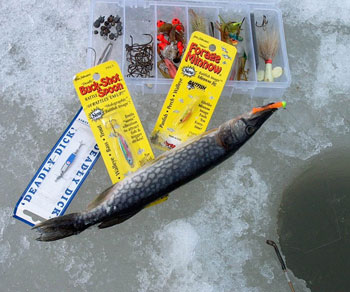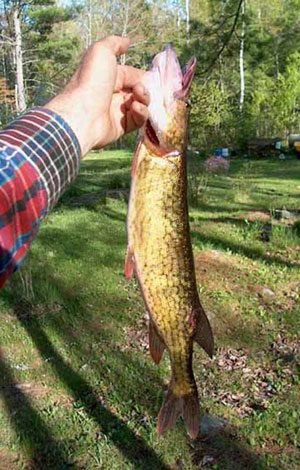
Pickerel like bright lures. The gear is simple, inexpensive, and readily available. Fishing pickerel is probably about the opposite of fly fishing when it comes to stuff, skill and technique. Photo by Tom Seymour |
Pickerel have sweet, flaky, flesh. Rows of fine, hairlike bones, however, give many people pause. In larger fish, the bones are easy to locate and remove. Bones in smaller fish are more problematical, but small fish lend themselves to a preparation method (more on that later) that renders the bones inconsequential.
Most people go pickerel fishing in winter. This has much to do with small, relatively shallow ponds freezing earliest. Even before the season opens for ice-fishing for trout and salmon, eager ice-fishers head out on small ponds in search of pickerel.
Basic Gear
Equipment needed for pickerel is minimal, compared to the elaborate gear so many trout and salmon fans use. Hook, line and sinker sounds more proverbial than factual, but really that’s all anyone needs to catch a pickerel through the ice. Sure, the line needs to be contained on some kind of device, but this can be a homemade tip-up, the kind that has an above-water spool.
Tip-ups incorporate a sliding weight on a length of thick wire. This wire is balanced on an axis, so that the end with the red flag points down. A loop of line hooks over the other, hooked end of the wire. When a fish pulls, the wire turns on its moveable axis and a weight slides down, holding the wire so that the flag stands up, signaling a bite.
Many pickerel fans use tip-ups that have been in their families for many generations. Others, use ice-fishing traps, spring-loaded devices that allow a flag to fly when the fish trips a device on the trap that works like the pan on a mousetrap. Either way, both serve to hold the bait, suspended, above bottom and also, to alert the angler that a fish has taken the bait.
Hand-operated chisels and augers suffice to cut holes through ice up to 14 inches thick and even more. Gas-operated devices work well but they are heavy, messy and for the most part, unnecessary.
A skimmer, something like what was once used to skim cream from the top of raw milk and now manufactured specifically for skimming ice chips from holes is a necessary item. After this, comes a bait bucket filled with shiners or other minnows and perhaps, a child’s, plastic sled to pull the traps, chisel and bait bucket. This is the basic equipment required for pickerel fishing. I have pared my needs down even more, though. Dispensing with the bait bucket and traps or tip-ups, I now use artificial lures, on the end of a special, ice-jigging rod.
Once, we had to make our own jigging rods from the tip of a regular-sized fishing rod and a section of broom handle. Now, manufacturers offer graphite-composite rods that are flexible as can be, yet strong enough to land the largest fish in the lake. Also, these new, one-piece, jigging rods have an extra advantage, in the form of oversized guides and tip-top, or end guide. These have large enough openings so that the line no longer freezes inside the guides, a real boon.
Some people probably doubt that artificial lures can catch as many pickerel as live bait. Rest assured, they do. In fact, my success with artificials often tops that of companions using bait. And given that jigging is so effective, let me also mention the great benefit realized by not constantly immersing your hands in icy water, baiting hooks, fussing with wet, cold spools and handling frozen lines.
With a jig rod and ice jig, just hold the rod in one hand, open the bail and let the bait plummet to bottom. It’s that simple. Open-faced reels work best for this, since line is more likely to freeze fast to the spool on closed-faced reels.
It pays, at the start, to cut several holes before letting a line down. The more the better, really. Of course if you use traps or tip-ups, Maine general law allows five lines, so it is necessary to cut at least five holes. For someone who only uses a jig rod, three or four holes are more than enough to begin.

Chain pickerel typically weigh 2 pounds or more and attain lengths of well over 20 inches. The Maine record pickerel weighed 7.02 pounds. And doubtless, larger specimens have been caught, cooked and eaten, without being weighed or measured. Photo by Tom Seymour |
Fishing Techniques
If using bait, just hook the minnow through both lips, so that it swims freely and lower it down to near bottom. With luck, a flag will fly on the first trap before the last is baited and set. When all five lines are baited and down, it’s just a matter of waiting, watching and once in awhile, checking the line to make sure a pickerel hasn’t stolen the bait.
When jigging, just let the jig down until line stops paying out. That means it has hit bottom. Then, reel up just a few turns and hold it perfectly still. Often, a pickerel will hit immediately, in which case it’s time to strike. Pickerel don’t always slash into a bait in winter, but instead, take it with a gentle tap. At any indication of a bite, faint strike or tap, it’s time to raise the rod and hook the fish.
If nothing bites, raise the rod up and let it down. Do this several times and then let it rest, motionless, once again. Keep repeating the process. If the hole seems fish-free, move on to the next one. But remember, fish that didn’t bite early on may become aggressive later. So return to those non-productive holes and try them again. This sometimes pays off, big-time.
In years past, ice-fishers had very few commercially-available ice-fishing jigs from which to choose. Today, tackle store shelves bulge with a wide array of jigs. Still, one old-timer, as productive now as it was 40 years ago, is a must-have in any tackle box. Swedish Pimple, an ice jig that comes with a treble hook on a split ring and a small, red, plastic flapper tag, takes pickerel like crazy. These somewhat resemble Diamond Jigs, the kind we use for mackerel in summer. But Swedish Pimples are three-sided, as opposed the four-sided, Diamond Jigs.
Oddly enough, I have had great success using panfish jigs, lures intended for open-water use, rather than ice-fishing. My favorites are Crappie Magnets, made by the same company that manufacturers Trout Magnets. These use a tapered-metal jighead and a solid, plastic body that slides over the hook. These come in a wide variety of color patterns, so it pays to keep trying different combinations on days when fish don’t cooperate.
Maine general law (this is in effect statewide, unless superceded by other, special regulations for that specific water) allows for a daily bag limit of 10 pickerel. Pickerel have no minimum length limit.
So think of it. Here we have a fish that we can catch with relative ease and even better, we can keep up to 10 of them to take home and eat. That’s a good deal. And, too, the conservation-minded needn’t feel guilty about killing and eating pickerel. In most every instance, pickerel are under-fished, meaning they are under-harvested. This, in its worse form, leads to a large population of stunted fish. Far better to “cull the crop” and allow fewer fish to compete for available food sources.
Pickerel Recipes
To prepare pickerel for cooking, place the fish on a wooden cutting board. Then, beginning from just behind the head, slice down with a fillet knife nearly to the backbone. Then turn the knife so it rides over the backbone and wiggle it down the length of the fish. This results in one, skin-on fillet. Repeat the process on the other side. Then, place one fillet skin-side down on the board and get a firm grip on a bit of skin with a fingernail. Work the knife tip down to the skin, twist flat and work the knife the length of the fillet.
After this, some people like to run their knife around the ribcage. This contains a large number of bones and discarding it makes eating easier. This helps with fish that are to be fried.
Pickerel, rolled in cornmeal and fried in a black-iron skillet in rendered salt pork, are an old-time favorite. This simple dish is hard to beat, too. Just cook on medium heat until one side turns golden-brown, flip and wait for the other side to brown. Test for doneness by flaking with a fork. If the meat flakes readily, it is ready. Remove from heat and drain on a paper towel.
Fried pickerel still have some bones. The next two recipes render the bones of no consequence.
Here is my grandma’s fishcake recipe. This is particularly suited for small pickerel, since the fillets must be ground before use. So if fishing with fishcakes in mind, keep all your pickerel, even small ones. The basic recipe calls for one cup of pickerel fillets. Expand this according to the size of your pickerel and the number of available fillets.
Gather:
1 cup skinned fillets
1 green pepper
1 small onion
1⁄3 cup bread crumbs
1 teaspoon dried parsley
1⁄4 teaspoon basil
1⁄4 teaspoon thyme
salt and pepper to taste
juice of 1⁄2 lemon
Grind the pickerel, along with the onion and pepper. In a large bowl, mix this with remaining ingredients. Remove, place on floured board and form into patties. Dredge the patties in flour prior to frying in oil to a golden brown. Drain on a paper towel.
Pickled Pickerel
If you like the commercially-available pickled herring sold in stores, this will be a big hit.
Gather:
6 skinless pickerel fillets
2 small-to-medium onions,
sliced very thin
1 cup white vinegar
1⁄2 cup water
2 oz. sugar (2 shot glasses)
1 teaspoon allspice
1⁄4 teaspoon salt
1⁄4 teaspoon pepper
Bay leaves
Salt (Kosher, pickling or table salt all work)
Rinse and drain fillets. Coat heavily with salt, both sides. Let stand in refrigerator for 24 hours. Rinse off salt, pat dry and cut into bite-sized pieces. Pack into 8-ounce jelly or canning jar, preferably wide-mouth, alternating layers of fish and onion slices. Tuck bay leaves down alongside contents.
Mix vinegar, water, sugar, allspice, salt and pepper in a glass cup. Stir until sugar dissolves. Slowly pour pickling solution into jars, filling to brim. Screw caps down then tap jar and shake, to allow trapped, air bubbles to float to surface. Refrigerate jars. Ready in three days, but keeps up to three weeks.
Pickerel, so much fun to fish for and to catch. Eating them, especially with these great recipes is just a bonus. |





